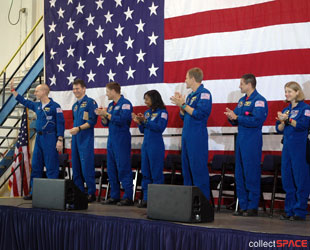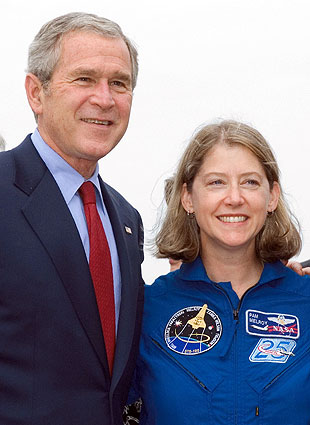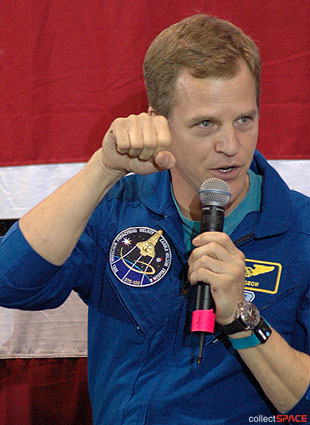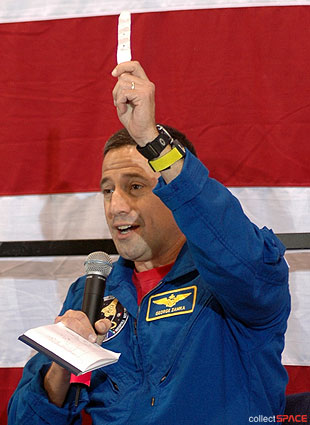|
|

|
Astronauts celebrated for 'terrific mission'

| The STS-120 crew and recent ISS resident Clay Anderson take to the stage inside Hangar 276 at Ellington Field in Houston. |
November 9, 2007 — Just a day after landing from their 15-day flight aboard space shuttle Discovery, the crew of STS-120 returned home to Houston on Thursday, where they were met by their NASA coworkers, family, friends, fans and the President of the United States George Bush.
The President, in town for other meetings, met the crew at Ellington Field as they were arriving from Florida and he was preparing to board Air Force One for San Antonio. Their meeting was private but Michael Coats, director of Johnson Space Center, shared some of Bush's words while introducing the astronauts to the assembled crowd.
"For the last 24 hours, I've been trying to think of the right words to describe this mission and all I could come up with was 'Wow, what a terrific mission,'" said Coats, who is also a former astronaut. "I felt bad about that. I felt like after 30 years in this business, I should be able to come up with something better than that."
"But this morning, when President Bush landed on Air Force One and I got to be one of the greeters out there to say hello to him, as soon as he got off the plane he said, 'Wow, what a terrific mission.' So I think that is pretty appropriate, it truly was a terrific mission," said Coats to laughter from the audience.

| STS-120 commander Pam Melroy with President Bush. (NASA) |
The 'terrific mission' was launched to deliver the Harmony node to the International Space Station. The Italian-built U.S. multi-port module will allow European and Japanese science labs to be added to the orbiting outpost.
"Harmony is just beautiful, it is an inspiration to see and it was an astronaut heaven. It was clean and bright and airy and beautiful," recalled STS-120 commander Pam Melroy speaking at her and her crew's homecoming.
Her favorite moment from the mission however, came as a result of something that wasn't planned when Discovery launched with her at the helm. After moving a large truss assembly to its permanent berth, Melroy's crew began to deploy its two power-providing solar array wings. The first array unfolded without issue. The second was nearly fully extended when a tear in its blanket was spotted. A daring spacewalk was quickly devised by flight controllers which required the crew build a set of array-stabilizing cuff links and to use the station's 50-foot robot arm and the orbiter's 50-foot inspection boom in a way never before attempted.
"By the end of the night before we were ready to go out, Peggy [Whitson, ISS commander] and George [Zamka, STS-120 pilot] had finished building the cuff links, the EVA [spacewalk] and robotics teams had several tag-ups independently and the whole crew came together, and this really required every single person on both crews to pull their weight and more to make it happen," recounted Melroy. "And everyone came together, and I just kind of hung back for a moment and listened, as everybody was talking about what needed to be done. And there were these ideas popping out of everybody's mouths. 'We have to remember this,' 'Don't forget that,' 'We're going to do this way and that will be the safest.' It was just wonderful to see the team come together and I knew that that was being reflected on the ground at the same time."
"That the best of everything was coming out," continued Melroy, "the engineering, ingenuity, the teamwork but most of all the total dedication to human spaceflight, to allow us to pull something incredible like that off. It was really amazing for me, it was on overwhelming moment."
The spacewalk itself was made by Scott Parazynski, a veteran of four earlier missions, and first-time flyer Doug "Wheels" Wheelock. Parazynski rode the arm and boom to the site of the tear while Wheelock monitored the array from its base, advising his spacewalking partner to take caution when the electrically-charged wing swayed close.
Wheelock was positioned such that he could keep sight of Parazynski, which had him out of direct sunlight and remaining stationary. That led ground controllers to warn him of the temperature.
"It was like, 'Oh yeah, Wheels, by the way, it is going to be a little cold down where you are,'" Wheelock explained, "so, I appreciate all the training we got on the [spacesuit] because I exercised every bit of that suit. It was freezing cold down there. I exercised my glove heaters for the first time and went into bypass on my EMU. My teeth were chattering, but I was trying to hold still there," confessed Wheelock.
While Wheels was 'down there', Parazynski was up high on the station arm (SSRMS) and orbiter's boom (OBSS).
"I'd also like to take you to the very highest branch of the tallest tree, the 'treetop' as I called it, on the end of the SSRMS, coupled with the OBSS boom, coupled with a WIF [worksite interface] adapter and then a foot restraint at the very top of all this thing, one foot away from an enormous solar array," said Parazynski. "I felt confident with Robeau [Stephanie Wilson] at the helm, also Dan Tani driving the arm, and knowing that brilliant men and women here at the Johnson Space Center had developed all the trajectories to get me there safely."
"After we had spent three, maybe four hours out there at the worksite, just an incredible sight, very intense, I was very focused, my whole universe was just the solar array in front of me, I did a layback and looked down at Wheels and I gave him the STS-120 salute which is a fist bump, and then spirit fingers," said Parazynksi as he performed the salute. "So, it's a fist bump with attitude."

| Scott Parazynski demonstrates the STS-120 salute. |
Assisting the spacewalkers from inside shuttle Discovery was European Space Agency astronaut Paolo Nespoli. As the 'IVA' crewmember, Nespoli's job was to relay the work that Parazynski and Wheels were to do outside. The three had trained together for many months before the mission for the flight's planned spacewalks, developing a camaraderie.
"We do a lot of talking during EVAs, we constantly talk, seven hours of talk, and I just talk, they work, but I talk," said Nespoli with a smile. "We put in a lot of humor and hidden things and some of them are pretty peppered. We had to tone it down because you know, half of the world is watching," he continued.
"Nevertheless, we managed to sneak in something, I guess, I hope some of the flight controllers were down [there] banging on their desks, because they knew what we were talking about. I tried to trick Scott one day into saying something that could not be said, I tried to trick him and he refused to say it, but I know the controllers knew what we were talking about and the flight directors, too. So I hope you got to laugh a little bit," Nespoli said.
Ultimately, the spacewalk was a success and the solar array was fully deployed. Parazynski installed five of the cuff links, which pilot Zamka had worked to build.
"This is what the solution was to that array," Zamka said as he took out from his pocket a cuff link's tab. "It's two pieces of aluminum strips that are cut and taped together with EVA tape taped around them, with holes punched in them and this is what Scott used with a couple of lengths of 12 gauge wire to fix the solar arrays."
Zamka turned his attention to the crowd, including those who had devised the repair. "You can't do this unless you live and breath this business, unless you spend time and you're a supporter and a booster of folks like us that helped to do this. I want you to remember the number '4' and the letter 'B', 4B, because that's the number and the letter of the array that you all fixed. So keep that in mind, and I am going to keep this as a memento of that," said Zamka as he returned the cuff link to his flightsuit pocket.

| George Zamka shows his space station cuff link memento. |
Zamka and his crewmates took turns thanking the people who had trained them and worked the flight.
"One of the best things about spaceflight is coming home to family and friends and our coworkers and colleagues and just being able to tell you how we carry you in our hearts when we're in space, your spirit is with us all of the time," said Stephanie Wilson.
Missing from the homecoming was the seventh crewmate to launch on Discovery, Dan Tani, who was transferred to the space station. Clay Anderson, who had been in space for 152 days, took Tani's place for the ride back to Earth.
"Exchanging crewmembers on the space station has to be, really, one of the most emotional things I have ever done or taken part in," said Melroy. "I've always said that flying in space is a pretty emotional experience to begin with but to be bringing Clay home to his family and of course, to be taking Dan to his home, even though it was a terrible wrench for us to leave him, it was a wonderful experience and we are just privileged to be a part of that."
Anderson, who noted he will begin his 25th year working for NASA at Johnson Space Center in January 2008, said it would be hard to top the timing of his stay in space.
"For a small town kid from the state of Nebraska, who launched on his father's birthday, and then had the opportunity to have the space shuttle Discovery and her crew come bring me home, which included a roll reversal, the first roll reversal on the entry trajectory over the state of Nebraska, and then to bring me down at KSC on my 15th wedding anniversary, I don't think you can write a script that is any better than that," Anderson observed. |

© 2023 collectSPACE.com All rights reserved.
Questions? E-mail [email protected]

|
|

|

|
